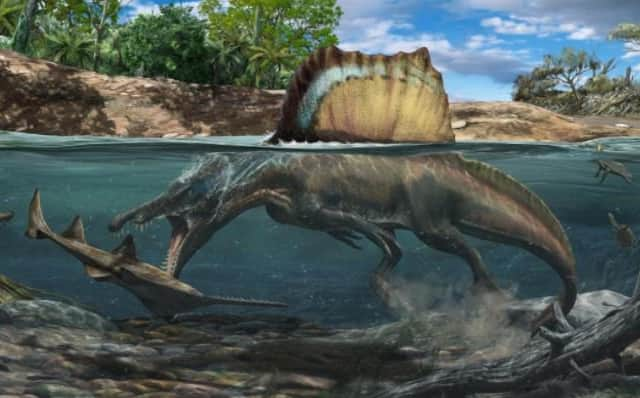Portsmouth lecturer spearheads new research into 'river monster' - the largest predatory dinosaur known
and live on Freeview channel 276
In the last decade palaeontologist and National Geographic Explorer Dr Nizar Ibrahim unearthed different parts of a Spinosaurus skeleton in North Africa’s Sahara Desert.
Spinosaurus is the largest predatory dinosaur known - over two metres longer than the longest Tyrannosaurus rex - but the way it hunted has been a subject of debate for decades.
Advertisement
Hide AdAdvertisement
Hide AdIn a new paper, published in Nature, a group of palaeontologists have taken a different approach to establish the lifestyle of the long-extinct creatures by examining the density of their bones.


By comparing them to other animals like penguins, hippos, and alligators, the team found that Spinosaurus and its close relative Baryonyx from the Cretaceous of the UK both had dense bones that would have allowed them to submerge themselves underwater to hunt.
Scientists already knew that spinosaurids had certain affinities with water - their elongate jaws and cone-shaped teeth are similar to those of fish-eating predators, and the ribcage of Baryonyx, from Surrey, even contained half-digested fish scales.
Dr Ibrahim and his team described retracted nostrils, short hind legs, paddle-like feet, and a fin-like tail: all signs that firmly pointed to an aquatic lifestyle.
Advertisement
Hide AdAdvertisement
Hide Ad

Dr Ibrahim said: ‘We battled sandstorms, flooding, snakes, scorpions and more to excavate the most enigmatic dinosaur in the world and now we have multiple lines of evidence all pointing in the same direction – the skeleton really has “water-loving dinosaur” written all over it.’
Based on its highly specialised anatomy, Dr Ibrahim and his team previously suggested that Spinosaurus could swim and actively pursue prey in the water, but others claimed it was not much of a swimmer and instead waded in the water like a giant heron.
Researchers have continued to debate whether Spinosaurus spent much of its time submerged, pursuing prey in the water, or if it just stood in the shallows and dipped its jaws in to snap up prey.
‘In part this is probably because we were challenging decade-old dogma – so even if you have a very strong case, you kind of expect a certain degree of pushback,’ Dr Ibrahim said.
Advertisement
Hide AdAdvertisement
Hide AdThis continuing debate led lead author Dr Matteo Fabbri, based at Chicago’s Field Museum, senior author Dr Ibrahim and an international team of researchers to try to find another way to find out about the lifestyle and ecology of long-extinct creatures like Spinosaurus.
Dr Fabbri said: ‘The idea for our study was clearly we can interpret the fossil data in different ways. But what about the general physical laws?
‘There are certain laws that are applicable to any organism on this planet. One of these laws regards density and the capability of submerging into water.’
Across the animal kingdom, bone density can tell us whether an animal is able to sink beneath the surface and swim.
Advertisement
Hide AdAdvertisement
Hide Ad‘Previous studies have shown that mammals adapted to water have dense, compact bone in their postcranial (behind the skull) skeletons,’ said Fabbri, an expert on the internal structure of bone. Dense bone helps with buoyancy control and allows the animal to submerge itself.
The team assembled a very large dataset of femur and rib bone cross-sections from 250 species of extinct and living animals, including both land-dwellers and water-dwellers, and covering animals ranging in weight from a few grams to several tonnes including seals, whales, elephants, mice, and even hummingbirds.
They also collected data on extinct marine reptiles like mosasaurs and plesiosaurs. The researchers compared bone cross sections of these animals to cross-sections of bone from Spinosaurus and its relatives Baryonyx and Suchomimus.
Dr Ibrahim said: ‘The scope of our study kept expanding because we kept thinking of more and more groups of vertebrates to include.’
Advertisement
Hide AdAdvertisement
Hide AdThe scientists found a clear link between bone density and aquatic foraging behaviour. Animals that submerge themselves underwater to find food have bones that are almost completely solid throughout, whereas cross-sections of land-dwellers’ bones look more like doughnuts, with hollow centres.
SEE ALSO: Angry Bishop hits out
Dr Ibrahim added: ‘The bones don’t lie, and now we know that even the internal architecture of the bones is entirely consistent with our interpretation of this animal as a giant predator hunting fish in vast rivers, using its paddle-like tail for propulsion.
‘It will be interesting to reconstruct in a lot more detail how these river monsters moved around – something we are already working on.’